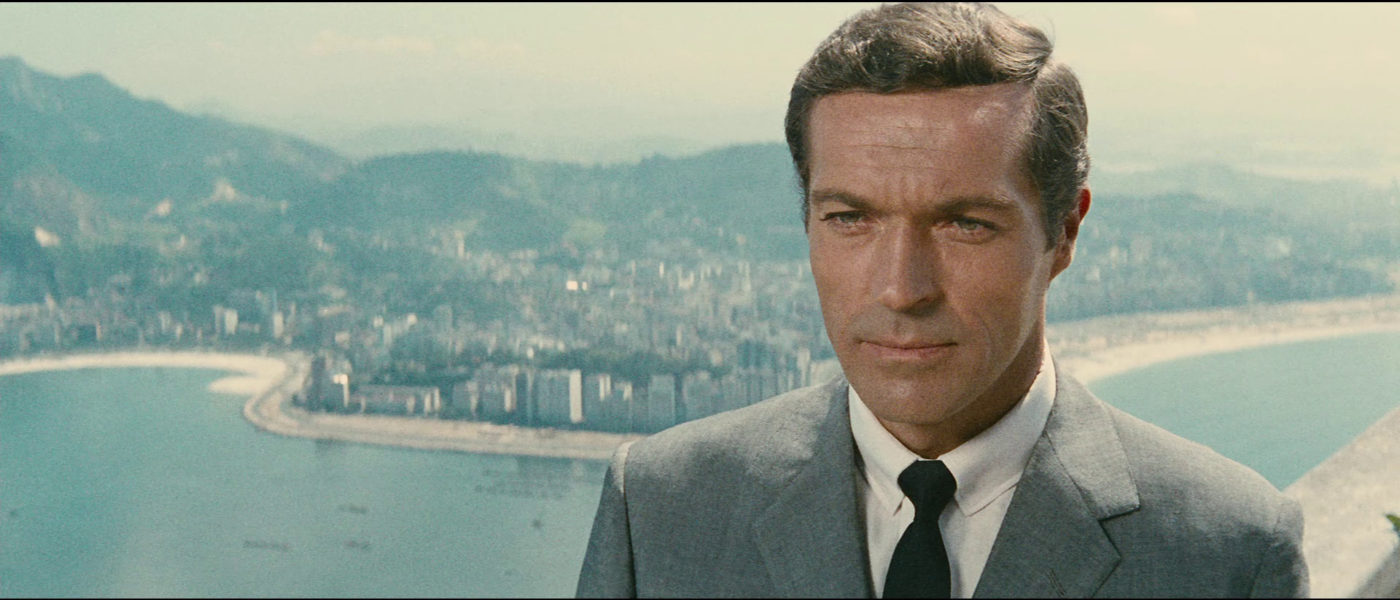Classic French Secret Agent Series is Dispatched to Blu-Ray
STREET DATE: SEPTEMBER 26, 2017/KINO LORBER STUDIO CLASSICS
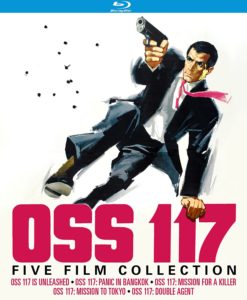 When 007 isn’t available, there’s only one international super spy that the world has turned to to take on Evil. Slick. Suave. Fashion forward. A real ladies man.
When 007 isn’t available, there’s only one international super spy that the world has turned to to take on Evil. Slick. Suave. Fashion forward. A real ladies man.
Of course I’m talking about the one, the only Austin Powers. (Can I get a “Yeah, Baby!”?)
In the wake of 1997’s Austin Powers: International Man of Mystery, it was clear to film
buffs that the most sophisticated level of comedy the film operates upon derives from its not being a spoof of James Bond movies per se, but from its deep-core riffing on the myriad of James Bond knockoffs that flooded screens in his wake. There was Matt Helm, there was Our Man Flint, there was even A Man Called Flintstone. And, in France, there was OSS 117. (Real name: Hubert Bonisseur de La Bath).
Actually, OSS 117 is based on a long, long, long running line of French spy novels, originating with author Jean Bruce, that hail from the 1950s onward. There are literally hundreds of them. Then perhaps it should be less surprising that the very first film adaptation (not included in this five film Blu-Ray set) predates any James Bond movie. Yet, the series that followed, beginning in 1963 with OSS 117 is Unleashed, exists inescapably in the shadow of the runaway success of the Broccoli/Saltzman Ian Fleming adaptations. This would prove to be the one predicament that our Agent Hubert could never get out of.
One would think that the French, of all people, would understand and possess what it takes to out-James Bond James Bond, but no. Along those lines though, it is good to be reminded that while the French New Wave was going strong in the early 1960s, those influential works by Truffaut, Godard, and company weren’t the only movies being made in France at the time. The country’s film industry could knock out 007 rip-offs just as readily, if not more so, than Hollywood or wherever else.
All five films are pretty safely within the “PG” rated zone, less racy or violent than Bond movies. That said, the OSS 117 series has its favored template and aesthetic, never far from from that of 007. Hubert’s suit is rarely ruffled and all the girls’ hair bands match their dresses. Happenin’ cars zip around while cool music plays. A little flirting (always successful), an adult beverage or two, and then some imposing heavy invades and draws a switchblade on our hero. Ruckuses of varying quality ensue, depending upon which of the five films you’re watching.
Let’s take a look at each film in the set, in order:
OSS 117 is Unleashed
DIRECTED BY ANDRÉ HUNEBELLE/FRENCH/1963
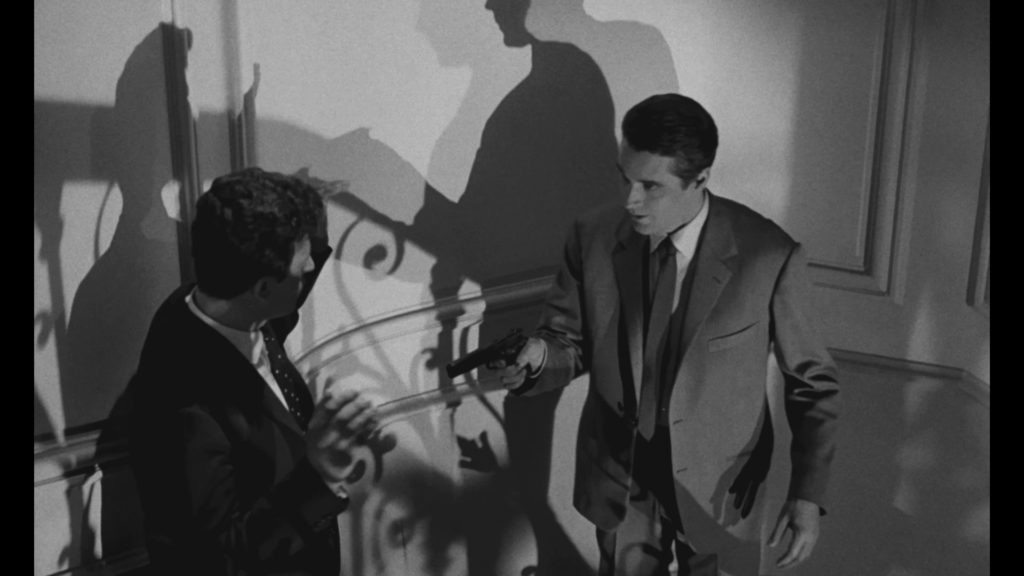
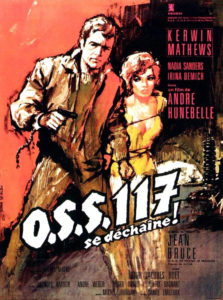 OSS 117 is Unleashed is the only one these five titles that is black and white, and clearly the work of a modest budget.
OSS 117 is Unleashed is the only one these five titles that is black and white, and clearly the work of a modest budget.
Kerwin Mathews, best known for several fantasy films from back in the day (7th Voyage of Sinbad, 3 Worlds of Gulliver, Jack the Giant Killer) debuts in his first of two outings as the title character.
This incarnation of the spy, a supposed ladies man, has all the suave debonair demeanor of Fantasy Island-era Ricardo Montalban. It’s probably no stretch to presume that Mathews, with little to no character meat to chew on, simply couldn’t shed his own homosexuality. Or, perhaps he was determined to not emulate Sean Connery in Dr. No, which came out the year prior. In any case, it just doesn’t work.
Mathews aside, the rest of OSS 117 is Unleashed has a certain hepcat bygone era vibe about, albeit not in an overt way. As for the plot, I watched it a week ago and can’t recall one detail.
OSS 117: Panic in Bangkok
DIRECTED BY ANDRÉ HUNEBELLE/FRENCH/1964
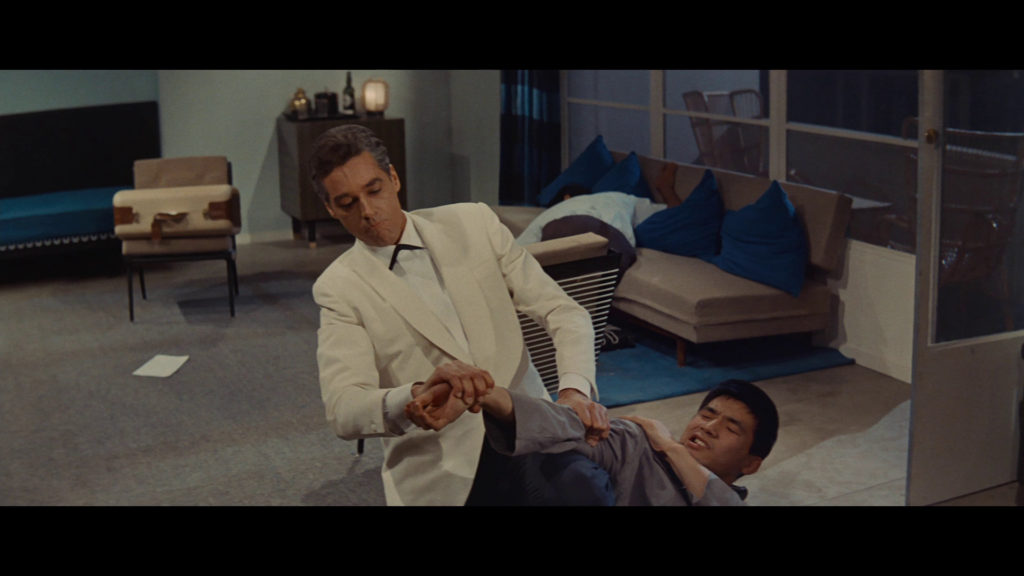
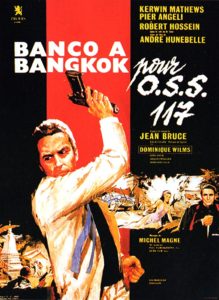 Here’s something interesting. In Bangkok, at least in the early 60s, it’s all the rage in men’s formal wear to sport your bowtie under your shirt collar.
Here’s something interesting. In Bangkok, at least in the early 60s, it’s all the rage in men’s formal wear to sport your bowtie under your shirt collar.
The Bangkok of this film definitely doesn’t come off as the dark gangster-ridden hellhole that The Hangover 2 presented. That film, in retrospect, was more of a “panic in Bangkok” that this film ever approaches. Here, we have just enough potential populace-threatening peril to warrant the dispatch of OSS 117.
There’s a super-suspicious character lurking about called “Dr. Sinn”. With a name like that, how could he not be trouble? At least he’s got a pretty sister, Lila Sinn. When she falls in with our protagonist (played by stonier Kerwin Mathews, as though compensating due to criticism), the scramble is on to sort out who the villain really might be, and how to stop him/her.
All music and decor, Panic in Bangkok prevails as one foot-tapping spy flick. With no shortage of whisky drinks and just enough style, one could think of it as Ultra Lounge: The Movie. (If a reference to Capitol Records’ excellent CD series of swingin’ 1950’s and 60’s nostalgia and deeper-cuts that ran its course two decades ago is too obscure of a reference for you, you’re reading about the wrong film series.)
While a definite step-up from its predecessor, Panic in Bangkok evidences a ways yet to go for the series, whomever casts it, and director André Henebelle, who made all but one of these films – and debatably, not the best one. It’s fight scenes are obviously fake, and riddled with tacky frame-shaving jump cuts, intended to pro up the excitement factor, but failing miserably. There’s also a most uncool car chase, in which a luggage buggy chases a lumpy white ambulance van in low-speed pursuit.
Keep at it, OSS 117 – Things do get better…
OSS 117: Mission for a Killer
DIRECTED BY ANDRÉ HUNEBELLE/FRENCH/1965
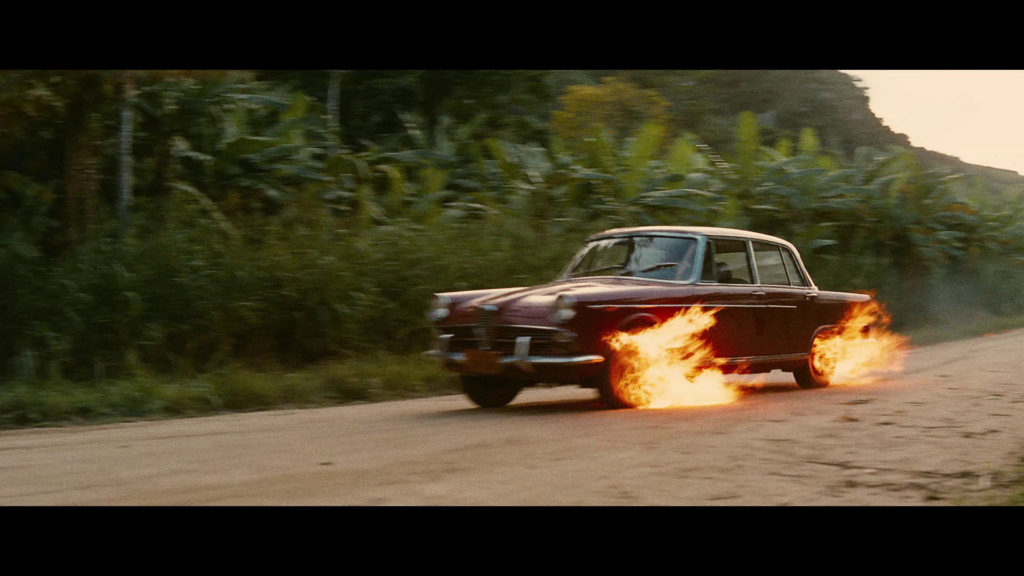
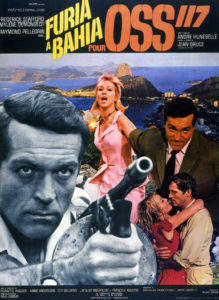 The series truly begins to hit its stride with this third entry, 1965’s Mission for a Killer. Kerwin Mathews has been disavowed , replaced with Frederick Stafford, who would go on to star in Hitchcock’s Topaz.
The series truly begins to hit its stride with this third entry, 1965’s Mission for a Killer. Kerwin Mathews has been disavowed , replaced with Frederick Stafford, who would go on to star in Hitchcock’s Topaz.
Unconventionally handsome but undeniably man-ish in the positive sense, Stanford quickly settles in as the best of all the OSS 117 actors. Unlike the other fellow, there’s never a moment when you doubt that this is the character. And, as is the case in all films of this ilk, once you’re on board with the character, you can get on board with the entire film. This seems true also for director Hunebelle, who is likewise catching his stride here.
Jetted off to Rio de Janeiro, and thrust into, as they say, a deadly game of cat and mouse. The first half of this nearly two hour affair (OSS 117 standard length) is deceptively tame; in keeping with the first two films.
Then, midway through, there’s a two on one fight in a hotel room involving a blowtorch. It’s pretty obvious that the actors themselves are struggling with one another, blue blazing blow torch in hand. Curtains are getting lit on fire, fire shooting at the camera, people are getting lit up in a bad way. All while kicking each other in the face. It’s not only the first time in the series that there’s a commendable action sequence, it’s the first time there’s a memorable moment, period. OSS 117 has come to life!
Later, its more fire as part of something resembling a car chase. Our hero intentionally drives his car through a huge wall of flames as the only means of escape, girl in tow. The tires catch fire, destroy the brakes, and threaten to ignite the gas tank. How does our hero get out of this one…?? (Answer: Editing.)
OSS 117: Mission to Tokyo
DIRECTED BY MICHEL BOISROND/FRENCH/1966
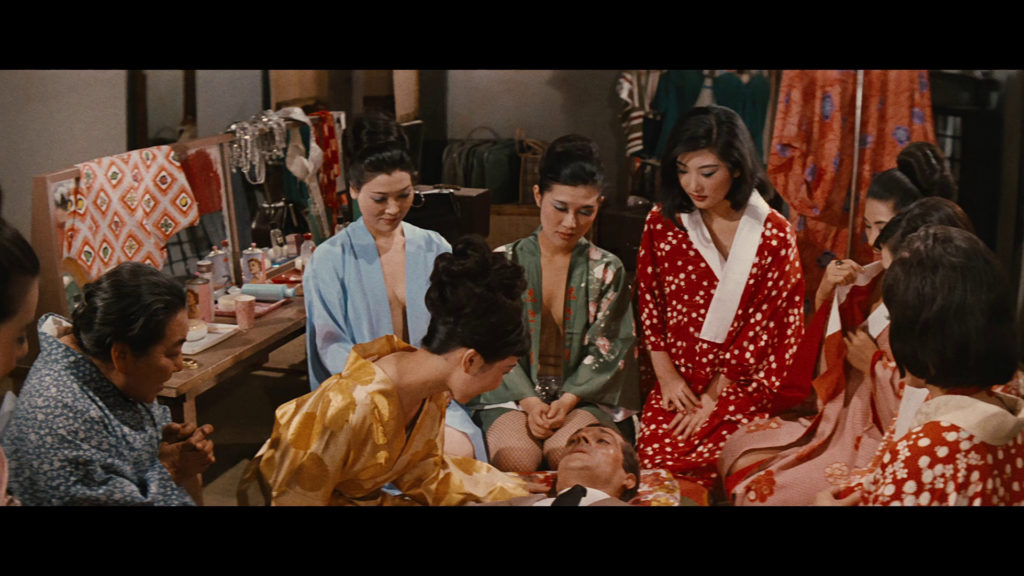
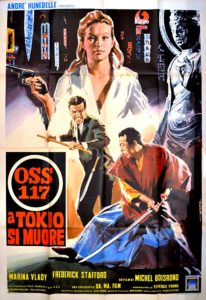 Finally, a decent car chase! Not only that, it opens cold in the middle of it… 007 style.
Finally, a decent car chase! Not only that, it opens cold in the middle of it… 007 style.
I realize that my take might very well read as me cheering for this film series to conform to another, but the alternative clearly hasn’t been working out. In regard to this installment’s successful conformity, much of it can likely be credited to a familiar co-screenwriter, Terence Young, director of Dr. No, From Russia with Love and Thunderball. It’s been pointed out that much of the cinematic Bond’s demeanor, class and swagger stems directly from Young, who was no small influence on the series.
Returning as agent Hubert Bonisseur de La Bath is Frederick Stafford, who again pulls his weight and proves his chops. He even sells a heretofore uncharacteristic retort, which is purely the kind of horribly uncouth sentiment we’ve come to expect from other super-spies of the era:
Beautiful Woman: “Have you ever been called a cad?”
OSS 117: “No. I kill people before they’ve time to say it.”
Do we quite believe him? As he might phrase it, no. But we fully believe that that would be a stock reply from this man, and one he might actually be able to parlay into a certain masculine charm. In 1966.
In keeping with the singular locale settings for this series, and as the title of this entry signifies, this is indeed a mission to Tokyo. Once there and on the case, OSS 117 memorably squares off with a massive sumo/samurai-type bruiser whom, once he gets enraged, makes short work of most of the surrounding shōji walls. This is one of several convincing action sequences that look like they hurt.
The finale is one of those “big finishes” with an army of faceless cannon fodder showing up to carry out a mini war against the bad guy’s faceless cannon fodder army. The details of the sequence are particularly dehumanizing, and even fly in the face of a central goal – freeing native captives from the villain’s prison, only to thrust them into a battle where they pretty much all get killed – but hey, it does make for prolonged wild battle sequence! Like the main character, the movie itself is a cad who kills before you get a chance to accuse. Perhaps in spite of ourselves, we leave Mission to Tokyo quite satisfied.
Tokyo also brings a new director to the helm, Michel Boisrond, replacing Hunebelle. And just when Hunebelle was getting good, too. Gauging only from this most watchable outing, though, Boisrond immediately seems to be a more natural fit for the job. Nevertheless, both he and Stafford are out following this film.
One more to go…
OSS 117: Double Agent (aka OSS 117 Murder for Sale)
DIRECTED BY ANDRÉ HUNEBELLE/FRENCH & ENGLISH/1968
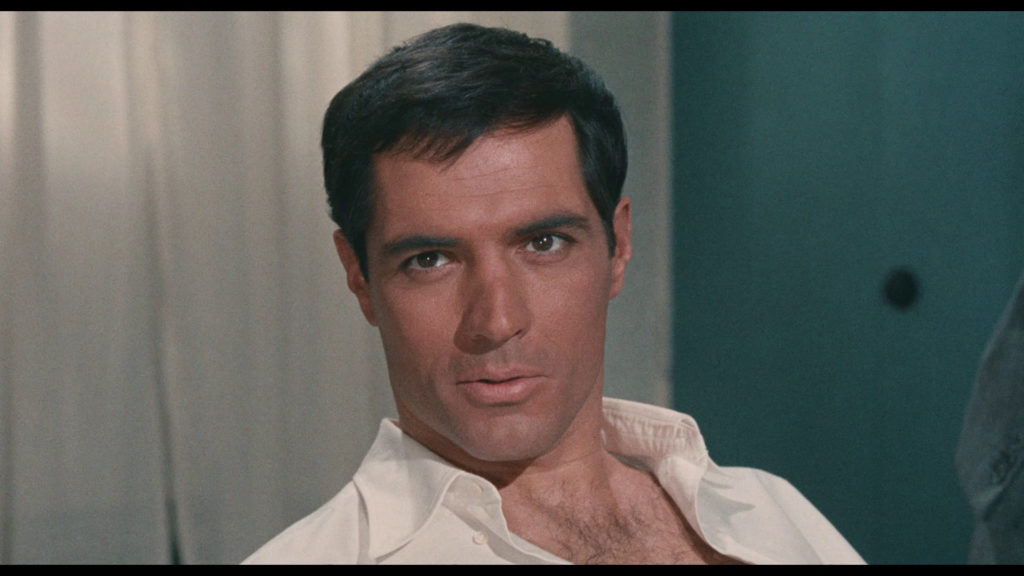
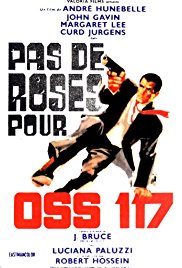 OSS 117 has gotten plastic surgery. Now, rather than resemble Frederick Stafford, he looks a lot like American actor John Gavin (Hitchcock’s Psycho). Also, he now looks exactly like a notorious French criminal. In this guise, he’s sent to infiltrate a super-secret assassination ring, one that the U.S. government has learned to be enabling its capitalist corporate clientele, killings that negatively stir the global pot, resulting in war profiteering in certain sectors.
OSS 117 has gotten plastic surgery. Now, rather than resemble Frederick Stafford, he looks a lot like American actor John Gavin (Hitchcock’s Psycho). Also, he now looks exactly like a notorious French criminal. In this guise, he’s sent to infiltrate a super-secret assassination ring, one that the U.S. government has learned to be enabling its capitalist corporate clientele, killings that negatively stir the global pot, resulting in war profiteering in certain sectors.
Running this diabolical Murder Incorporated is an older Caucasian man whose eyes, hair and jacket are in perpetual competition for being his steeliest feature. Since Charles Grey was likely occupied at the time making The Devil Rides Out or You Only Live Twice, similar actor Curd Jürgens plays the part. (Of course, Jürgens would later lend his silvery stare to the great Roger Moore Bond entry The Spy Who Loved Me.)
Double Agent, while far from the worst of the bunch, is marred on several fronts. Inescapably, it’s got some of the worst action music in any film, ever. And, after two entries that finally put the practice behind them, the action scenes in Double Agent once again resort to using jump cuts within shots to shore up the pacing. These cuts are supposed to be unnoticed, hidden amid the excitement of whatever fisticuffs are playing out. In today’s age of frenetic pacing and amazing stunt work, though, this type of thing cannot cut it. I suspect that even then, this was cause for demoted points from audiences. Double Agent offers nothing grand in the way of the flamethrower fight in Mission for a Killer or the battle with the huge man in Mission to Tokyo.
John Gavin, does fine with the French language, though a bit more of this film is in English than any of the other four. There are moments where Gavin, perhaps notably fresh off of the saccharinely innocuous Thoroughly Modern Millie, appears thoroughly out of his element. It is he, however, whose likeness swiftly adorns the cover of this five-film collection, a cool image of his leaping and shooting translated directly from a moment early in the movie.
*****
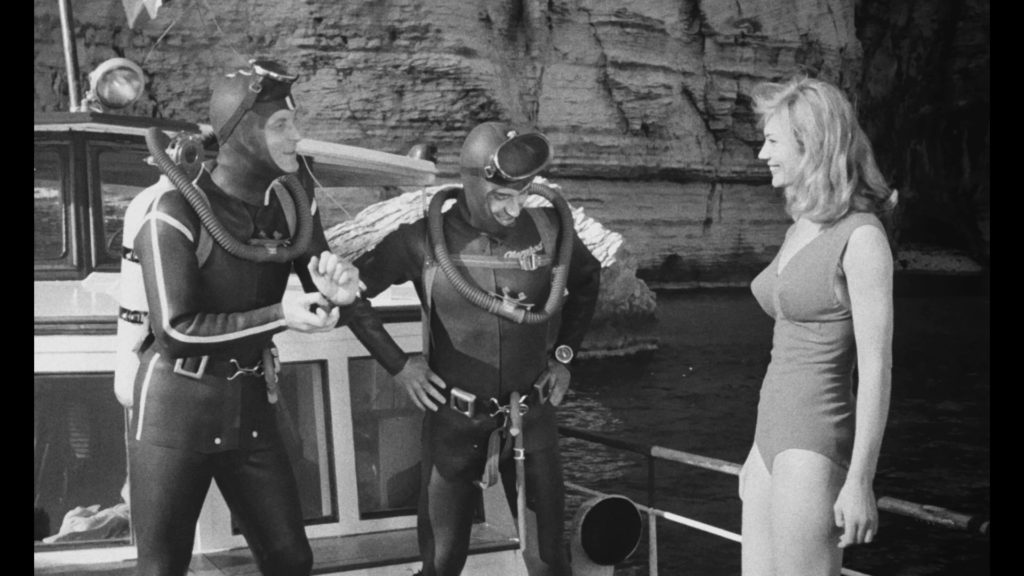 As pure 1960s espionage entertainment, these five titles are a mixed bag. Only the two Frederick Stanford entries, Mission for a Killer and Mission to Tokyo, deliver the goods. This set, at the right price, might be worth it for these two titles alone.
As pure 1960s espionage entertainment, these five titles are a mixed bag. Only the two Frederick Stanford entries, Mission for a Killer and Mission to Tokyo, deliver the goods. This set, at the right price, might be worth it for these two titles alone.
As for the rest… Imagine if a workaday secret agent of John LaCarre’s world decided to try his hand at operating ala 007. Now imagine that the whole affair is underfunded and in French. Viola, you’ve unleashed OSS 117.
My nine year daughter pegged these as James Bond rip-offs that are made up of “too much of what doesn’t matter, and not nearly enough of what does”. We can have a continental super spy, pretty ladies, exotic locales, and even a few gadgets here and there, but when lacking charisma or spectacle, OSS 117 might as well stay in the hotel.
This series has less continuity than the Bond films, which is saying something. One could cherry pick the order of viewing these OSS 117 films, and miss nothing (aside from the obvious natural evolution of the series, and specifically director André Hunebelle’s approach). I’d rank them thusly, best to worst:
- Mission to Tokyo (1966)
- Mission for a Killer (1965)
- Double Agent (1968)
- Panic in Bangkok (1964)
- OSS 117 is Unleashed (1963)
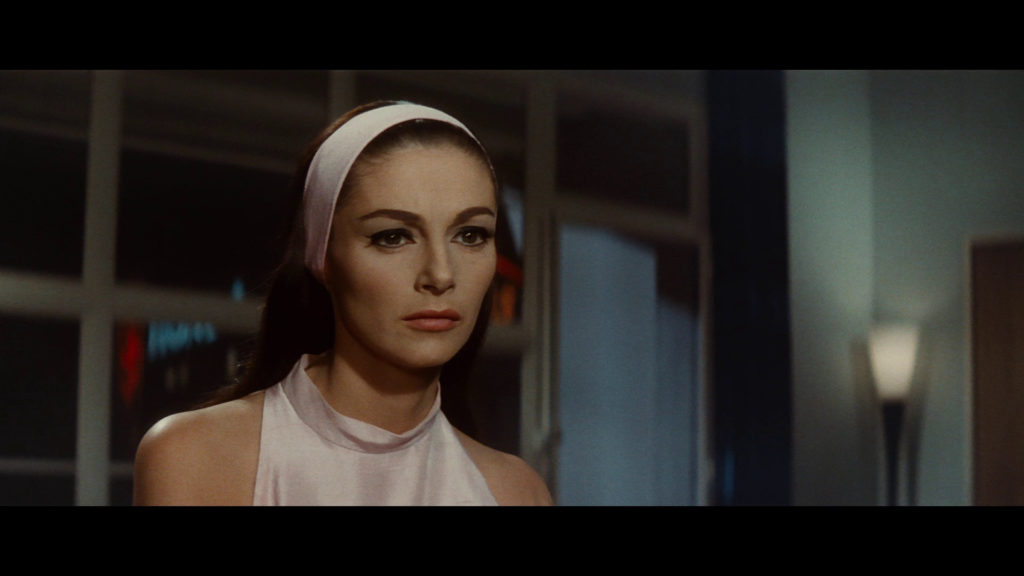 The true, non-dismissive value of this set lies in its presentation of these undeniable cultural artifacts. On that level, each film is never completely unengaging. Each actor foists a different style of attempted charm onto the character, with wildly varying degrees of success. If one can look passed any such shortcomings, with a forgiving mind towards what is and isn’t working on screen, the series will play all the better.
The true, non-dismissive value of this set lies in its presentation of these undeniable cultural artifacts. On that level, each film is never completely unengaging. Each actor foists a different style of attempted charm onto the character, with wildly varying degrees of success. If one can look passed any such shortcomings, with a forgiving mind towards what is and isn’t working on screen, the series will play all the better.
The restorations are vibrant and impressive, lending a crisp yet filmic newness to to proceedings. Unfortunately, there are no extras on the set’s three discs, aside from vintage trailers for the first three films.
OSS 117, with his overly chirpy theme song and revolving door of lead actors and supporting players, will nonetheless have sociologically minded viewers declaring a hearty “Yeah, baby!”. Kino Lorber Studio Classics’ release of the OSS 117 Five Film Collection is an undeniably attractive release for anyone interested in a variation on the 007 1960s milieu, something that culturally defies death to this day.
Image credits: dvdbeaver.com


